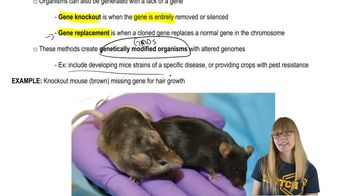Table of contents
- 1. Introduction to Genetics51m
- 2. Mendel's Laws of Inheritance3h 37m
- 3. Extensions to Mendelian Inheritance2h 41m
- 4. Genetic Mapping and Linkage2h 28m
- 5. Genetics of Bacteria and Viruses1h 21m
- 6. Chromosomal Variation1h 48m
- 7. DNA and Chromosome Structure56m
- 8. DNA Replication1h 10m
- 9. Mitosis and Meiosis1h 34m
- 10. Transcription1h 0m
- 11. Translation58m
- 12. Gene Regulation in Prokaryotes1h 19m
- 13. Gene Regulation in Eukaryotes44m
- 14. Genetic Control of Development44m
- 15. Genomes and Genomics1h 50m
- 16. Transposable Elements47m
- 17. Mutation, Repair, and Recombination1h 6m
- 18. Molecular Genetic Tools19m
- 19. Cancer Genetics29m
- 20. Quantitative Genetics1h 26m
- 21. Population Genetics50m
- 22. Evolutionary Genetics29m
17. Mutation, Repair, and Recombination
Types of Mutations
Problem 16a
Textbook Question
Textbook QuestionDominant mutations can be categorized according to whether they increase or decrease the overall activity of a gene or gene product. Although a loss-of-function mutation (a mutation that inactivates the gene product) is usually recessive, for some genes, one dose of the normal gene product, encoded by the normal allele, is not sufficient to produce a normal phenotype. In this case, a loss-of-function mutation in the gene will be dominant, and the gene is said to be haploinsufficient. A second category of dominant mutation is the gain-of-function mutation, which results in a new activity or increased activity or expression of a gene or gene product. The gene therapy technique currently being used in clinical trials involves the 'addition' to somatic cells of a normal copy of a gene. In other words, a normal copy of the gene is inserted into the genome of the mutant somatic cell, but the mutated copy of the gene is not removed or replaced. Will this strategy work for either of the two aforementioned types of dominant mutations?
 Verified Solution
Verified SolutionThis video solution was recommended by our tutors as helpful for the problem above
Video duration:
6mPlay a video:
Was this helpful?
Key Concepts
Here are the essential concepts you must grasp in order to answer the question correctly.
Haploinsufficiency
Haploinsufficiency occurs when a single functional copy of a gene is insufficient to maintain normal function, leading to a dominant phenotype. In this scenario, a loss-of-function mutation in one allele results in a phenotype that is expressed even in the presence of a normal allele. This concept is crucial for understanding how certain genetic disorders can manifest despite having one normal gene copy.
Recommended video:
Guided course

Mutations and Phenotypes
Gain-of-Function Mutations
Gain-of-function mutations lead to an increase in the activity or expression of a gene product, often resulting in a dominant phenotype. These mutations can create new functions or enhance existing ones, which can contribute to various diseases, including cancers. Understanding this concept is essential for analyzing how certain mutations can lead to abnormal cellular behavior.
Recommended video:
Guided course

Functional Genomics
Gene Therapy
Gene therapy involves introducing a normal copy of a gene into somatic cells to compensate for a mutated gene, aiming to restore normal function. This technique is particularly relevant for conditions caused by loss-of-function mutations. However, its effectiveness can vary depending on whether the mutation is haploinsufficient or a gain-of-function mutation, as the underlying mechanisms differ significantly.
Recommended video:
Guided course

Transgenic Organisms and Gene Therapy

 9:49m
9:49mWatch next
Master Point Mutations with a bite sized video explanation from Kylia Goodner
Start learning


